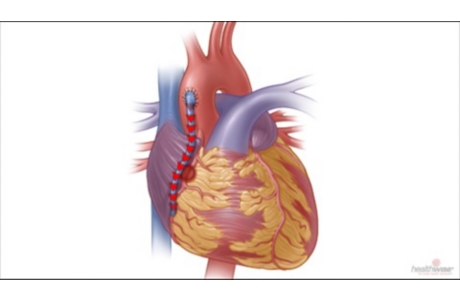Coronary Artery Bypass Surgery: Day One of Recovery
Topic Overview

What happens in the first 24 hours after CABG surgery?
After your coronary artery bypass graft (CABG) surgery is finished, you will be transferred to a cardiac intensive care unit (CICU) or surgical ICU so that specially trained hospital staff can monitor your condition. The recovery process is different for every patient, so the amount of time you spend in the specialized ward will vary.
When your need for monitoring decreases, you will be transferred to a step-down unit in the hospital in preparation for your return home.
During your recovery from bypass surgery, you will hear one universal theme: Everyone heals at a different pace. Your experience may vary from the typical course discussed below.
Immediately after your surgery
General anesthesia is used during the CABG procedure, so you may be unconscious for several hours after surgery. Exactly when you wake up depends on a number of things. For example, additional medicines to control complications during or after your surgery may keep you unconscious longer.
While you are still unconscious, you will probably be taken to the intensive care unit, a special ward reserved for people who have just had significant surgeries. You might be in this unit for 1 to 3 days. A longer stay does not mean that your CABG surgery was not successful. It may mean, for example, that it is taking more time for your anesthesia to wear off or for fluid in your chest to drain.
As you wake up, you may notice several sensations. You will probably feel very groggy. Anesthesia can make you feel nauseated, so your stomach may feel queasy. You may also notice immediately that you cannot swallow or speak because of the tube placed in your throat to help you breathe. You may also hear a lot of noise: the equipment and monitors used in most intensive care wards can make a lot of beeping noises.
Although the effects of anesthesia usually help with the discomfort from CABG surgery, you still may experience some pain after you are awake. To relieve this discomfort, your nurse will give you pain medicine through your intravenous (IV) line directly after surgery.
When you become more alert, your doctor will prescribe pain medicine. You may have a small machine that allows you to control when and how much pain medicine you get, although this is more common after 24 to 48 hours. This machine (a PCA pump) has a device that you hold in your hand with a button to press to start medicine flowing through your IV line.
Getting out of the intensive care unit
When your condition has improved, you will be transferred from the specialized ward to a normal cardiac care unit, sometimes called a step-down unit. Most hospital step-down units have significantly fewer nurses and monitoring personnel, so you are usually transferred there when:
- Your breathing tube has been removed.
- You are able to take medicines orally.
- Invasive tubes and monitoring requirements are reduced.
Removing the breathing tube
The tube from the ventilator to your lungs helps you breathe during your CABG surgery. Your doctor will remove this tube when you are conscious and able to breathe on your own. Less frequently, you may be completely alert, yet unable to breathe without a ventilator. This means that you have not yet regained enough strength.
Your breathing tube reaches a long way down into your windpipe, so you may need to exhale forcefully to help your respiratory therapist remove it. Even if you have a strong gag reflex, the tube’s removal should not cause you to vomit, because the nasogastric tube, also called an NG tube, will have drained any fluids from your stomach out through your nose both during and after surgery.
Taking oral medicines
When your doctor thinks you are ready, your NG tube will be removed and you should be able to swallow food as well as medicines. A major step in your recovery is switching from intravenous (by IV line) to oral (by mouth) medicines. The ability to do this shows that you are fully conscious and are at a certain level of medical independence. Your IV line will remain in even though you are able to take pills.
Removing other tubes and monitors
You will have several tubes and monitors placed in and around your body to monitor your progress during recovery. Careful monitoring is needed after surgery to check for complications. Within a few days after you begin your recovery, these tubes are usually removed. This shows that your recovery is moving forward and you don’t need to be watched as closely.
You may no longer need the urinary catheter that was placed in your bladder. When you are in the step-down unit, you may be able to move in and out of bed. Using a bathroom or bedpan to urinate may be more practical and comfortable.
What to think about
After you have been transferred to a step-down unit, you will most likely be in the hospital only a few more days. During this time, your medical team will continue to monitor your condition and watch for any complications that may delay your return home. You will need to meet another set of criteria before you can go home.
Current as of: April 9, 2019
Author: Healthwise Staff
Medical Review:Rakesh K. Pai, MD – Cardiology, Electrophysiology & Martin J. Gabica, MD – Family Medicine & Adam Husney, MD – Family Medicine & David C. Stuesse, MD – Cardiac and Thoracic Surgery
This information does not replace the advice of a doctor. Healthwise, Incorporated, disclaims any warranty or liability for your use of this information. Your use of this information means that you agree to the Terms of Use. Learn how we develop our content.
<script src=”https://cont






